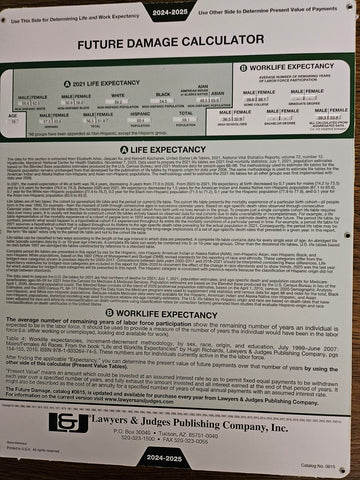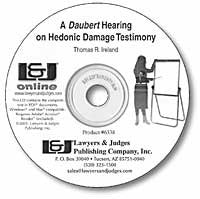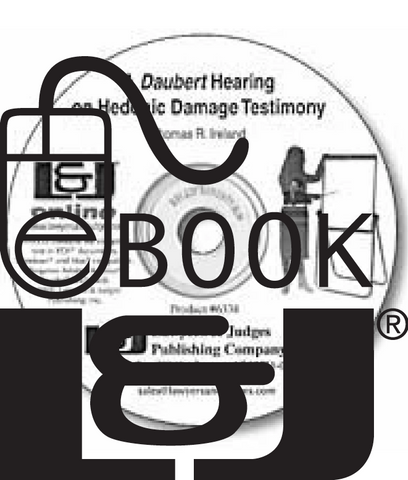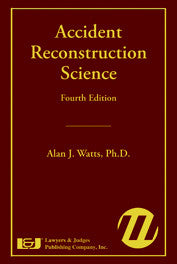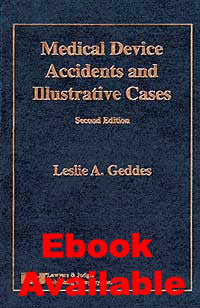
Medical Device Accidents & Ilustrative Cases, Second Edition
-
Author: Leslie A. Geddes
-
ISBN 10: 1-930056-36-2
-
ISBN 13: 978-1-930056-36-7
-
Copyright Date Ed: July 30, 2002
-
Pages: 492 pages
-
Binding Information: Hardcover
-
Product Dimensions: 6 x 9 inches
This enhanced second edition of the unique Medical Device Accidents gives you even more useful information about problems that can occur with a medical device. This book is filled with information, examples and case studies that will help you win any medical suit involving devices. Written with attorneys, expert witnesses, clinical engineers, nurses, physicians, manufacturers and designers of new medical devices in mind, this excellent resource will answer all of your questions about these devices.
Leslie Geddes has fifty years of experience in his field. New in this edition: entire chapters devoted to catheter electrodes, transdermal drug transport and pain suppression by electrical stimulation, with discussions of their side effects and hazards. This second edition of Medical Device Accidents is about 150 percent as long as the first edition and contains many more case studies and examples that should help you with any medical device accident case you encounter.
In this information-packed volume, you will find out the consequences of applying two technologies to a patient simultaneously. Discover hints, tips, and observations for expert witness testimony. Learn about real case studies, describing the kinds of injuries that can occur. Read the discussions on high frequency electric cutting, describing injuries caused by burning, bowel gas explosions, and circumcision.
Medical Device Accidents will tell you all about the intended use of a product and criteria for establishing a product defect or a design defect. It describes the customer's expectations of a product and the responsibility of a manufacturer. It goes into depth on electrosurgery, electrocautery and laser surgery. It talks about pacemakers and cellular phones and interference between devices.
Topics covered:
- Product liability
- Medical technology
- Identifying product defect, design defect, misuse, negligence
- Statutory medical device reporting
- Incident reporting
- The increasing use of electronic controls (analog and digital)
- Susceptibility of medical devices to electromagnetic interference (EMI)
- Malfunctions within apnea monitors, ECG, EEG instruments, ventilators, drug infusion pumps, pacemakers, automatic-implante defibrillators, and other devices
- Electrosurgical accidents
- Anesthetic accidents
- Intravascular catheters
- Direct-current injuries
- Pressure and chemical injury, including allergic responses
- Skin and instrument disinfectants and sterilization
- Observations and tips for the expert witness
Table of Contents
Preface
Chapter 1: Product Liability and Medical Technology
1.1 Introduction
1.2 Medical Device Evolution
1.3 Medical Malpractice
1.4 Medical Technology
1.5 Misuse
1.6 Negligence
1.7 Product Liability
1.8 Elements of a Product Liability Case
A. Manufacturing or production defect
B. Design defect
C. Failure to adequately instruct
D. Instruction manual
E. Failure to adequately warn
F. A too-well-designed product?
1.9 The Untested Product
A. Performance level safety factor and testing
B. Product variability
C. Distribution curves
D. Practical application of the distribution curve
E. Choice of a safety factor
1.10 Product Life
1.11 Medical Device Reports
1.12 Chemical Accidents
1.13 The Incident Report
1.14 Product Liability Future
References and Bibliography
Chapter 2: Electromagnetic Interference and Electrostatic Discharge
2.1 Introduction
2.2 Sources of EMI
A. Radio broadcasting
B. Television
C. Public safety (police, fire, highway, forestry, and emergency services)
D. Land transportation (taxis, trucks, buses, railroads)
E. Amateur radio
F. Cellular phones and paging systems
G. Industrial, scientific, and medical
H. Citizens' band (CB) radio
I. Radar
2.3 Frequency, Wavelength, and Antenna Effect
2.4 Skin Depth
2.5 Modulation
2.6 Examples of Device Malfunction Due to EMI
A. Patient simulator
B. Electrical equivalent for a subject
C. Electroencephalographic interference
D. Electrocardiographic interference
E. Impedance-based apnea monitor mishaps
1. Monitor alarms
2. Mechanism of death due to apnea
3. Susceptibility to EMI
F. Ventilator mishaps
G. Drug-infusion pump mishaps
H. Powered-vehicle mishaps
2.7 Cellular and Mobile Telephone-Generated EMI
A. Infant radiant warmer mishaps
B. Miscellaneous medical device mishaps
C. Health effects
D. Blood pressure monitor
2.8 Cardiac Pacemakers and EMI
A. Introduction
B. Closed-chest cardiac pacemakers
C. Implanted pacemakers
D. The cardiac cycle
E. Four-letter code
F. Communication with an implanted pacemaker
G. Failure modes
H. Effect of EMI on pacemaker function
I. Pacemaker malfunction due to electrosurgery
J. Abandoned pacemaker lead accident
K. Pacemaker malfunction due to paging system
L. Effects of mobile-phone EMI on pacemakers
M. Pacemaker malfunction due to cellular phones
N. Pacemaker malfunction due to magnetic resonance imagers
O. Pacemaker malfunction due to microwave-oven EMI
P. Pacemaker malfunction due to low-frequency EMI
Q. Implanted cardioverter defibrillator (ICD)
1. Ventricular defibrillation and cardioversion
2. Implanted cardioverter defibrillator operation
3. ICD control and monitoring
4. Effect of EMI on ICDs
5. ICD malfunction due to arc welders
6. Cell-phone EMI
7. Slot machine EMI
8. Pacemaker and ICD interaction
9. Improper electrode placement
10. Powerline ICD accident
R. Electronic surveillance systems
1. Types of surveillance systems
2. Electronic article surveillance (EAS) systems
3. Interactions with implanted devices
a. Implanted cardiac pacemakers
b. Conclusions about pacemarker-EAS interactions
c. Pain-suppression stimulators
d. Implanted cardioverter defibrillators (ICDs)
4. Metal detectors
a. Background
b. Cardiac pacemaker interaction
5. Dynamic cardiomyoplasty stimulator
6. Electromagnetic field strength of metal detectors
7. Conclusion
2.9 Electrostatic Discharge
A. Introduction
B. ESD testing
C. Mechanism of action of ESD
D. ESD incidents
E. Effect of ESD on human subjects
References
Chapter 3: Electrosurgery, Electrocautery and Laser Surgery
3.1 Introduction
3.2 Electrodes
A. Active (monopolar) electrodes
B. Electrode holster
C. Incidents with cut-coag electrodes
D. Bipolar electrodes
3.3 Dispersive Electrodes
A. Conductive dispersive electrodes
B. Uniform current-density electrode
C. Capacitive dispersive electrode
D. Reuse of disposable dispersive electrodes
E. Dispersive electrode monitors
1. Patient sentry
2. Current comparator
3. Patient-return monitor
4. Performance standards
3.4 Types of Current
3.5 Isolated-Output Electrosurgical Unit
3.6 Tissue Responses
A. Cutting
B. Desiccation
C. Coagulation
D. Argon-enhanced coagulation
3.7 Current Crowding
A. Introduction
B. Temperature rise due to current crowding
3.8 Complications with Electrosurgical Current
A. Muscle contraction
B. Pacemaker accidents
3.9 The Skin
A. Anatomy
B. Skin burns
C. Diagnostic difficulties
3.10 Experimental Burn Studies
3.11 Accidental Burns
A. Burns under ECG electrodes
1. Temperature-probe accidents
2. Airway fires
3.12 Endoscopic Electrosurgery
A. Urological applications
B. Injury to the urologist
C. Polypectomy
D. Explosions in the gastrointestinal tract
E. Laparoscopic sterilization
F. Tubal coagulation accidents
G. Circumcision accidents
H. Spermatic cord coagulation
3.13 Summary and Conclusions about Electrosurgery
3.14 Electrocautery
3.15 Laser Surgery
A. Laser system components
B. Laser hazards
C. Fire
D. Laser accidents
1. Airway fires
2. Laser-induced circumcision accident
3. Bowel perforation
3.16 Laser Transmyocardial Revascularization
References
Chapter 4: Anesthesia
4.1 Introduction
4.2 Anesthesia Machine
A. In-circuit vaporizer anesthesia machine
B. Out-of-circuit vaporizer anesthesia machine
4.3 Endotracheal Tube
4.4 Auxiliary Equipment
4.5 Monitoring Equipment
A. Anesthesia-machine monitoring
B. Patient monitoring
C. Alarms
4.6 Anesthesia Machine Mishaps
A. Carbon-dioxide absorber failure
B. Valve malfunction
C. Leaks and disconnections
4.7 Pulse Oximeter
A. Principle of operation
B. Oxygen saturation
C. Oxygen dissociation curve
D. Hazards and accidents with pulse oximetry
4.8 Capnograph
4.9 Burns from Warming Devices
4.10 Fire
A. Introduction
B. Defibrillator-induced fire
C. Electrosurgically induced fire
1. Facial injury
2. Airway fires
D. Laser-induced fire
4.11 ECRI Alert
4.12 Anesthesia Gas Mixtures for Use with Lasers
A. General
B. Flammability index
4.13 Blood-Pressure Monitoring Incidents
4.14 Impedance Cardiography Incidents
4.15 Muscle Relaxant Monitoring Incidents
4.16 Peripheral Nerve Stimulator Incidents
4.17 Somatosensory Evoked Potentials (SSEP) Monitoring Incidents
References
Chapter 5: Catheters and Catheter Electrodes
5.1 Introduction
5.2 The F Scale for Catheter Diameter
5.3 Intravascular Catheter Incidents
A. Catheter whip
B. Catheter pinchoff or clavicular crush
C. Swan-Ganz catheter
1. Operation and use
2. Accidents
D. Cardiac catheterization aneurysm accident
E. Balloon angioplasty
1. General characteristics
2. Technique
F. Stents
1. Description and use
2. Accidents
5.4 Conducting Properties of Fluid-Filled Catheters
A. Current sinks and sources
B. Electrosurgically induced ventricular fibrillation with fluid-filled catheters
C. 60-Hz leakage current induced ventricular fibrillation
5.5 Catheter Electrodes
A. Catheter (clavicular) crush
B. The twiddler's syndrome
C. Inappropriate ICD shocks due to electrode failures
5.6 Implant-Site Infection
5.7 Removal of Intracardiac Leads
A. General
B. Lead-extraction devices
1. Mechanical devices
2. Laser-assisted extractor
3. Electrosurgical-assisted extractor
4. Complications with lead extractors
a. Mechanical extractors
b. Laser-assisted lead extraction experience
c. Electrosurgical lead extractor experience
References
Chapter 6: Transdermal Drug Transport
6.1 Introduction
6.2 Accident with Skin-Patch Drug Delivery
6.3 Iontophoresis
A. Side effects
B. Iontophoresis accidents
6.4 Ultrasonic Facilitation of Transdermal Drug Delivery
A. Coupling agent
B. Mechanisms of action
C. Side effects
D. Ultrasound experiences in physical medicine
6.5 Electroporation
A. Electrical parameters for electroporation
B. Transdermal drug delivery by electroporation
C. Stimulation of excitable tissue
References
Chapter 7: Pain Suppression by Electrical Stimulation
7.1 Introduction
7.2 Transcutaneous Electrical Nerve Stimulation (TENS)
A. Introduction
B. Mechanisms of pain inhibition
C. Current-pulse characteristics
D. Electrode placement
E. Electrode types
F. Standards of performance
G. Complications with TENS units
7.3 Peripheral Nerve Stimulation (PNS)
7.4 Dorsal Column Stimulation (DCS)
7.5 Complications and Hazards With PNS and DCS Systems
7.6 Complications With Dorsal Column Stimulators
7.7 Electroacupuncture
7.8 Stunning Devices
References
Chapter 8: Tissue Injury
8.1 Introduction
8.2 Burn Treachery and the Blanch Test
8.3 Experimental Burn Studies
8.4 Radiant Heater Burns
8.5 Skin Temperature
8.6 Hand-Washing Water Temperature
8.7 Tap-Water Burns
8.8 Injury from Hot Packs
8.9 Ischemic Injury
A. Pressure injury
B. Incidence of pressure sores
C. Pressure lesions from electrodes
D. Bedsore classification
E. Pressure-sore sites
F. Shear-force injury
8.10 Neuropathy Following Anesthesia
8.11 Reflex Sympathetic Dystrophy (RSD)
8.12 Chemical Injury
A. Introduction
B. Chemical toxicity
C. Ethylene oxide sterilization
1. Accidents with ETO-sterilized items
2. Summary
D. Glutaraldehyde sterilization
1. Toxicity
2. Accidents with glutaraldehyde sterilization
E. Antiseptic solutions
1. Skin preparation
2. Iodine compounds
3. Mercury compounds
4. Mercury poisoning
F. Allergic responses
1. Allergic contact dermatitis
2. The patch test
3. Alcohol allergy
4. Skin rashes associated with recording bioelectric events
a. Electrocardiography (ECG)
b. Electroencephalography (EEG)
c. Electronystagmography (ENG)
d. Electrosurgical electrodes
5. Allergenic metals
a. Nickel
b. Mercury
c. Gold
d. Metals in military missiles
e. Cobalt allergy
8.13 Allergic Response to Bed Linens
8.14 Allergic Response to Rubber and Plastics
8.15 Conclusion
References
Chapter 9: Important Information for the Technical Expert
9.1 Introduction
9.2 Medical Device Accidents
9.3 Accident Investigation
9.4 Time of Death
9.5 The Technical Expert
9.6 Technical Expert Roles
9.7 Admissibility of Evidence
9.8 Copyrights
9.9 Patents
A. Introduction
B. Anatomy of a patent
C. Infringement
D. Doctrine of equivalents
E. Establishing infringement
F. Invalidation
G. Claims chart
9.10 Discovery
9.11 The Report
9.12 The Deposition
9.13 Chronology of a Case
9.14 The Courtroom
9.15 Attorney Styles
9.16 Payment for Services
9.17 Expert Witness Malpractice
9.18 Expert Witness Immunity
9.19 Liability
9.20 Where to Find Information
A. Medical device accidents
B. Medical device standards
C. Legal documents
Referencesocuments
References
About the Author
Index

